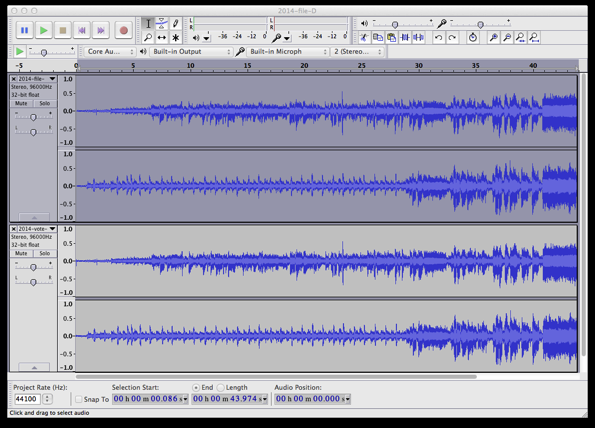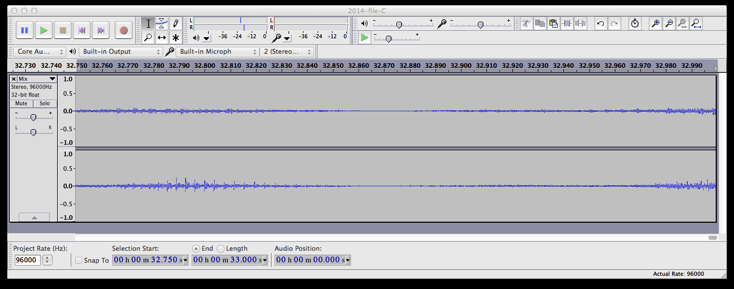Audiophilia
Humans are hard-wired to find patterns.
Even when there are none.
Explaining those patterns (at least, the ones which are real) is what science is all about. But, even there, lie pitfalls. Have you really controlled for all of the variable which might have led to the result?
A certain audiophile and journalist posted a pair of files, containing a ~43sec clip of music, and challenged his readers to see if they could hear the difference between them. Sure enough, “File A” sounds a touch brighter than “File B.” A lively discussion ensued, before he revealed the “reason” for the difference:
- File B was recorded, from his turntable, via a straight-through cable.
- File A was recorded, from his turntable, via a cable that passed through a switchbox.
Somehow or other, the switchbox (or the associated cabling) was responsible for the added brightness. An even more lively discussion ensued.
Now, if you open up the two files in Audacity, you discover something interesting: File A gets from the beginning of the musical clip to the same point at the end of the clip 43 milliseconds faster than File B does. That’s a 0.1% difference in speed (and hence pitch) of the recording. Such a difference, while too small to be directly discernible as a change in pitch, ought to be clearly perceptible as “brighter.”
On the other hand, I would contend that putting a switchbox in the signal path cannot possibly cause the information, traveling down the wire, to have shorter duration. The far more likely explanation was that there was a 0.1% variation in the speed of Mr. Fremer’s turntable between the two recordings.
I used Audacity’s “Change speed …” effect to slow down File A (by -0.099 percent), clipped the result (so that the two files have exactly the same duration), and posted them below.
See if you can tell which one is Mr. Fremer’s File A, and which is his File B, and, more importantly, whether you can detect a difference in the brightness (or edginess or whatever other audiophiliac descriptions you’d like to attach to them), now that the speed difference has been corrected.
Update: (2/9/2014)
As I said in the comments, and as anyone who opens up the files in Audacity immediately discovers, it is easy to tell which file is which, by examining their waveforms. Here are Files “B” (upper) and “D” (lower)
(click on any image for a larger view). It’s not obvious, from this picture that they’re the same (bear with me, about that). But, if we think they are, it’s easy enough to check.
- First, zoom in as far as you can.
- Then use the time-shift tool, to align the two waveforms precisely, at some point in the clip. It’s best to focus on a segment with some high frequency (rapidly varying) content. Fortunately, the pops and clicks on Mr. Fremer’s vinyl record give us plenty to choose from.
- Now select one of the wave-forms, and choose “
Effect“→”Invert”. - Finally, select both and choose “
Tracks“→”Mix and Render”.
If we’re correct, the two traces should precisely cancel each other out.
And they do (except for the little bits at the beginning and end that I trimmed in creating File “D”). Note that I magnified the vertical scale by a factor of 5, so that you can really see the perfect cancellation.
You can repeat the same procedure for Files “B” and “C” but, no matter how carefully you perform step 2, you can never get anything close to perfect cancellation. So, without even listening to the files, Mr. Fremer (after he got over his initial misapprehension that “C” and “D” were the same) was able to confidently determine which was which.
In a way, that’s rather disappointing, because it doesn’t really tell us anything about how different “C” and “D” are, and whether fixing the speed of the former diminished, in any way, the perceptible differences between them. As Mr. Fremer says,
As to how the two files sound, I didn’t have time last night to listen but will do so today. Of course I know which is which so I’m not sure what my result might prove.
But, since we have Audacity fired up, let’s see what the story is.
Though I said that, for the clip as a whole, there’s no way to line the tracks, so as to achieve cancellation, on a short-enough timescale, you can get very good (though, of course, not perfect) cancellation. The cancellation doesn’t persist – the tracks wander in and out of phase with each other☭, due (at least in part, if not in toto) to the wow-and-flutter of Mr. Fremer’s turntable.
Here’s an example (chosen because Mr. Fremer seemed to think that there’s a flagrant disparity in the waveforms, right in the middle of this excerpt).
Following the procedure outlined above, we align the two clips at the center, and attempt to cancel the waveforms:
They cancel very well at the center, but progressively poorly as you move to either end, where the two tracks wander out-of-phase. Notice the sharp spikes. If you zoom in, you’ll notice that these are actually S-shaped: they’re the result of superposing two musical peaks (one of which we inverted, of course) that have gotten slightly out-of-phase with each other. They cancel at the center, but not at either end, where they have ceased to overlap. Of course, not just the peaks but everything else has also gone out-of-phase, so these S-shaped spikes sit on top of an incomprehensible hash.
You can repeat the process for other short excerpts, with similar-looking results.
Now, “Andy”, below, says he heard a systematic difference between the files, similar to what others reported for Fremer’s Files “A” and “B.” That bears further investigation. But I’ve said to Mr. Fremer that, if he really wants to get to the bottom of what differences, if any, the cables contributed to these recordings, it would be best to eliminate the wow-and-flutter that is clearly responsible for most (if not all) of the visible differences displayed here.
He should start with a digital source (like, say, one of the 24/96 FLAC files we’ve been discussing), played back through the two different cables he wants to test. That source, at least, won’t vary (in a random and uncontrollable fashion) from one playback to the next.
Repeatability is another one of those things that we strive for in Science.
☭ In fact, it is that wandering in-and-out of phase that is the most glaring difference between the files and it (rather than the more sophisticated procedure that I outlined above) is what makes it trivial, for even a casual observer, to pick out which file is which.





Re: Audiophilia
So I have listened to these two samples. I have invited co-workers to listen to them and I have invited guests of our establishment to listen to them. All of us have used the very same computer station, volume, settings etc. and none of the listeners other than myself were introduced to the context of this listening. All of us (admittedly, only 5 people) have said we hear them as being different. All of us have also stated individually, again without prompting or context added, that File C is a brighter/harsher/more revealing version and that File D is warmer/fuller/stuffier sounding. I don’t know what result you are hoping/expecting/predicting but that is what 5 people thought here. I hope you update this at some point with your own ‘tell’ of what you are testing. Do you hear a difference?